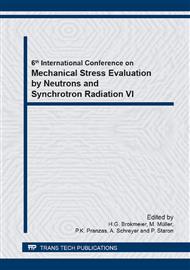[1]
T. Wroblewski, et al., X-Ray imaging of polycrystalline materials, Rev. Sci. Instrum. Vol. 66 (1995), 3560-2562.
Google Scholar
[2]
T. Wroblewski , et al., A new diffractometer for materials science and imaging at HASYLAB beamline G3, Nucl. Instrum. Methods A 428 (1999) 570-582.
Google Scholar
[3]
T. Wroblewski, A. Bjeoumikhov, X-ray diffraction imaging of bulk polycrystalline materials, Nucl. Instrum. Meth. A 538 (2005) 771-777.
Google Scholar
[4]
T. Wroblewski, E. Jansen, W. Schäfer, R. Skowronek, Neutron imaging of bulk polycrystalline materials, Nucl. Instrum. Meth. A 423 (1999) 428-434.
Google Scholar
[5]
T. Wroblewski, X-ray imaging of polycrystalline and amorphous materials, Advances in X-ray analysis 40, CD-ROM.
Google Scholar
[6]
T. Wroblewski, Self-organized criticality – a model for recrystallization?, Zeitschrift für Metallkunde, 93 (2002) 1228-1232.
DOI: 10.3139/146.021228
Google Scholar
[7]
J. Almanstötter, P. Schade, D. Stein, T. Wroblewski, Diffraction imaging of recrystallization in tungsten wire coils for incandescent lamps, HASYLAB Annual Report 1999, 891-892.
Google Scholar
[8]
G. Harding, M. Newton, J. Kosanetzky, Energy-dispersive X-ray diffraction tomography, Phys. Med. Biol. 35 (1990), 33-41.
DOI: 10.1088/0031-9155/35/1/004
Google Scholar
[9]
C. Hall et al., Synchrotron energy-dispersive X-ray diffraction tomography, Nucl. Instrum. Meth. B 140 (1998) 253-257.
Google Scholar
[10]
C.C.T. Hansson, K.H. Khor, R.J. Cernik, Coherent imaging using diffracted X-rays, Crystallography Reports, 55 (2010) 1162-1173.
DOI: 10.1134/s1063774510070102
Google Scholar
[11]
L. Strüder, High-resolution imaging X-ray spectrometers, Nucl. Instrum. Meth. A454 (2000) 73-113.
Google Scholar
[12]
O. Scharf, et al., Compact pnCCD-based X-ray camera with high spatial and energy resolution: A colour X-ray camera, Analytical Chemistry 83(7) (2011) 2532-2538.
DOI: 10.1021/ac102811p
Google Scholar
[13]
W. Leitenberger, R. Hartmann, U. Pietsch, R. Andritschke, I. Starke, L. Strüder, Application of a pnCCD in X-ray diffraction: a three dimensional X-ray detector, J. Synchrotron Rad. 15 (2008) 449-457.
DOI: 10.1107/s0909049508018931
Google Scholar
[14]
J. Staun Olsen, B. Buras, L. Gerward and S. Steenstrup, A spectrometer for X-ray energy dispersive diffraction using synchrotron radiation, J. Phys. E: Sci. Instrum. 14 (1981) 1154-1158.
DOI: 10.1088/0022-3735/14/10/015
Google Scholar
[15]
I. Ordavo et al, A new pnCCD-based color X-ray camera for fast spatial and energy-resolved measurements, Nucl. Instrum. Meth. A 654(1) (2011) 250-257.
Google Scholar


